Passenger Bogies
A “truck”, or in British terminology a “bogie”, is the wheel assembly on a train car, consisting of the wheels, axles, bolsters and associated hardware. The JR Group companies and JNR before them used a number of standard types of trucks on locomotive-hauled passenger cars. The Japanese term (“形台車” or “Katachi daisha”) is translated (by Google anyway) as “Dolly Form”. This page provides a partial list of those used on Japanese trains. Because of the sparsity of information, and the wide use of passenger cars of the same design under JNR, I have not limited this page to those found in the Tōkyō region.
Information on this page largely comes from the wikipedia pages cited at the bottom of the page, machine-translated. As such it is doubly-suspicious and errors of detail are probable. The general picture it provides is likely correct.
Passenger Car Trucks
The following models are used on locomotive-hauled passenger cars. Note: online information on these is somewhat sparse and many of the translations more cryptic than usual. Errors are likely.
TR47
This was originally used on the SUHA 43 and SUHANI 16 and recycled into the SUYUNE 50 when those were scrapped. It was also used as a replacement upgrade on the OHANE 17 sleeping car for the 10-series trains (built c. 1961), replacing earlier use of the TR23 and/or the TR34 (the article is unclear, but it appears that the TR23 was original from 1961, the TR34 was a replacement c. 1966 and the TR47 was added later; there’s also a comment suggesting that the later modification made the car into a SUHANE 16, note the different spelling from SUHANI, it is a different Japanese character, so it’s possible that these were not the same car).
Note: the photo below is characterized as a TR47 simply because it is on a SUHANE 16. Given the confusion above, as well as the age of the car and the lack of a second photo for confirmation, this is a tentative assignment. The truck could easily have been a later replacement.
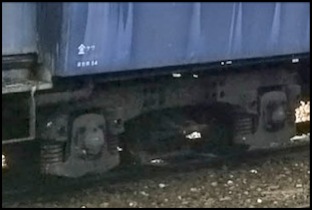
SUHANE 16 truck, probably a TR47
Photographer: Nagao Nobuyuki (永尾信幸) (1983)
TR50
This was an older form used on series 10 passenger cars.
TR54, TR54A, TR54C
The TR54 truck was used on the MANI 20 generator car (built 1958) and the TR54A on the KANI 20 generator car (built 1959) of series 20 trains. The TR54A has an increased load capacity of 43 tons. The TR54C was used on the MAYA 24 (built 1973); this version was equipped with coil springs. See also the TR55 entry.
TR55
This version was derived from the TR50 and used on series 20 passenger cars (built from 1958 to 1970), or possibly only on the dining car of those trains. It added an air-cushion to the existing springs of the TR50. There’s also a comment about a damper, but it’s not clear if that was part of this, a later addition to it, or something on another model. I think it’s saying that the same damper design was used on TR54, TR54A, TR55 and TR66, but the translation isn’t clear.
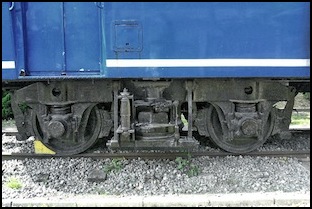
TR55 truck on series 20 passenger car
Photographer: Muyo (2007)
TR60
This appears to have been an air-spring fitted descendent of the TR55 used on the ORONE 10 sleeper car (there’s a confusing statement that seems to say both follow the TR20 design). The one very poor photo I’ve seen of one of these has some similarity to the TR55, but that may be only in general form (it wasn’t a detailed photo).
TR66, TR66B, TR66C
The TR66 truck was used on the KANI 21 (built 1960 to 1963) generator car of series 20 trains. This appears to have had an increased load capacity of 63 tons and was a revision of the TR54 design. The TR66B was used on the KANI 24, series 0, generator car (built 1974) of 24-series trains, including the Twilight Express and Akebono. The TR66C was used on the KANI 24 series 100 (built 1974 - 1980), which have also been used on the Twilight Express. See also the TR55 entry.
Note: based on the above, the photo below should be a TR66C. I’ve seen a near-identical photo (unfortunately of poor quality) that should have been a TR66B, so the two were likely visually identical, or at least very similar. Also note the lack of a metal structure directly above the axle (as found on the TR55 and later TR230) and the dual outer springs. This truck seems to have more similarity to the one identified above as a TR47, although it has the same dual-spring-plus-damper design in the middle as the TR230B seen below.
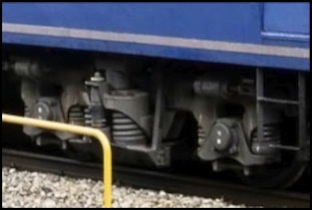
KANI 24 - 104 with what is likely a TR66C at Kyoto Station)
Photographer: 出々 吾壱 (1999)
TR203
This was an air-spring design with a rubber axle block, rated for 100 kph use and developed for freight cars equipped with a conductor’s office. The TR203 was apparently also used on the NAHA 29000-series passenger cars produced for a barbecue train by JR Hokkaido in 2000. This was likely a recycling of older trucks as it appears these cars were based on the KOKI 10000 container flat car. See the entry under freight trucks.
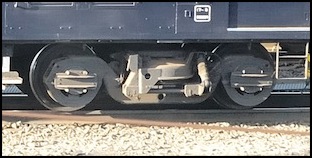
TR203 on NAHA 29002
Photographer: 出々 吾壱 (2006)
TR217, TR217C, TR217D
The TR217 truck was an air spring design developed for use on the series 12 (built 1969 - 1978) and later used on the series 50 type 5000 (or possibly one car of this series had these as a late addition). The series 12 was rated for 110 kph operation. The TR217B was used on a later series of OKHA12 and OHAFU12 (built 1971), and the TR217C was used on a later series of OKHA12 (built 1978) as well as on later SUHAFU 12 (built 1970). The TR217D was used on a later series of SUHAFU 12 (built 1971). The TR217C and TR217D were also used on series 50 cars that were limited to 50 kph, although this doesn’t appear to be a limitation of the truck itself due to its use on the series 12.
I have seen a photo of a very similar design (complete with air spring) truck used on an OHANE 25, which suggests the 24-series also used these, although I haven’t seen any documentation for that.
A number of Series 12 cars were used as the basis for 1980’s / 1990’s loco-hauled “Joyful” trains, and thus those would have also used this design unless the refurbishment replaced them.
Note: the TR217 illustrated below is from a JR Shikoku SUROFU12, which appears to have been a late (c. 1988) construction or conversion based on the OKHA12, suggesting it used the TR217C form.
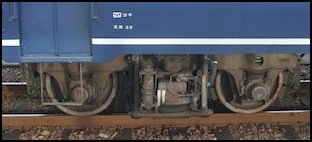
TR217 on a SUROFU 12 (this may be a TR217C)
Photographer: Mitsuki-2368 (2007)
TR230, TR230A TR230B
The TR230 truck was used on the MANI 24 series 0 baggage car used by JR Hokkaido on the Hokutosei, and on the MANI 50 series baggage car used by JR East on their version of the same train (at least I think that’s what it says; they may both be references to the MANI 24). The TR230A was equipped with “rubber-coated coil springs” and pillows (bumpers?) and used on a series 51 car of some kind (OHAFU 51, I think), built in 1979. The TR230B truck was used on the MANI 30 series express baggage car (the “Money Car” used to deliver banknotes for the Bank of Japan) and the series 50 passenger cars. The TR230 was a “sealed roller bearing” truck design and was developed from the TR217. There are references to series 50 cars being upgraded to 110 kph when their TR217C or TR217D trucks were replaced with TR230 trucks in 1997 (and a photo of an OHAFU 50 seems to confirm use of this style by the series 50).
It would appear that the use of dual coil springs in the center, rather than a single large air spring, is the primary visual feature that distinguishes the TR230 from the TR217.
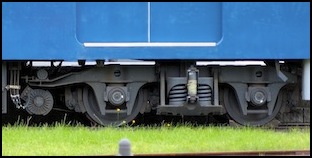
TR230B (with generator) on MANI 30 at Otaru University Museum
Photographer: 出々 吾壱 (2007)
References
Series 10 Passenger Car (Japanese Wikipedia)
Series 12 Passenger Car (Japanese Wikipedia)
Series 24 Passenger Car (Japanese Wikipedia)
Series 50 Passenger Car (Japanese Wikipedia)




